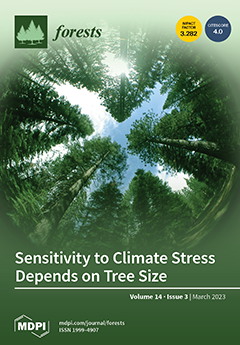Currently, 3D tree modeling in a highly heterogeneous forest environment remains a significant challenge for the modeler. Previous research has only focused on morphological characteristics and parameters, overlooking the impact of micro-environmental factors (e.g., spatial-structural diversification and habitat heterogeneity) and providing less structural information about the individual tree and decreasing the applicability and authenticity of 3D tree models in a virtual forest. In this paper, we chose a mixed-forest conversion of Chinese fir (
Cunninghamia lanceolata) plantations in a subtropical region of China as our study subject and proposed a novel 3D tree-modeling method based on a structural unit (TMSU). Our approach modified traditional rule-based tree modeling (RTM) by introducing a nonlinear mixed-effect model (NLME) to study the coupling response between the spatial structures and morphological characteristics (e.g., tree height (H), height-to-crown base (H
CB), and crown width (CW)) of three dominant trees (e.g.,
Cunninghamia lanceolata (SM),
Machilus pauhoi (BHN), and
Schima superba (MH)) and develop a prediction model of the morphological characteristic by incorporating forest-based structural parameters. The results showed that: (1) The NLME model in TMSU was found to better fit the data and predict the morphological characteristics than the OLS model in RTM. As compared to the RTM morphological model, the prediction accuracy of the TMSU model of morphological features was improved by 10.4%, 3.02%, and 17.8%, for SM’s H, H
CB, and CW, respectively; 6.5%, 7.6%, and 8.9% for BHN’s H, H
CB, and CW, respectively; and 13.3%, 15.7%, and 13.4% for MH’s H, H
CB, and CW, respectively. (2) The spatial-structural parameters of crowding (
), mingling (
), and dominance (
) had a significant impact on the morphological characteristics of SM, BHN, and MH in TMSU. The degree of crowding, for example, had a positive relationship with tree height, height-to-crown base, and crown width in SM, BHN, and MH; under the same crowding conditions, mingling was positively correlated with tree crown width in SM, and dominance was positively correlated with tree height but negatively correlated with height-to-crown base in BHN; under the same crowding and mingling, dominance was positively correlated with height-to-crown base in MH. (3) Using 25 scenes based on the value class of
for SM, 25 scenes based on the value class of
for BHN, and 125 scenes based on the value class of
for MH, we generated the model libraries for the three dominating species based on TMSU. As a result, our TSMU method outperformed the traditional 3D tree-modeling method RTM in a complex and highly heterogeneous spatial structure of a forest stand, and it provided more information concerning the spatial structure based on the neighborhood relationships than the simple morphological characteristics; a higher morphological prediction accuracy with fewer parameters; and the relationship between the spatial-structural parameters and the morphological characteristics of a reference tree.
Full article





